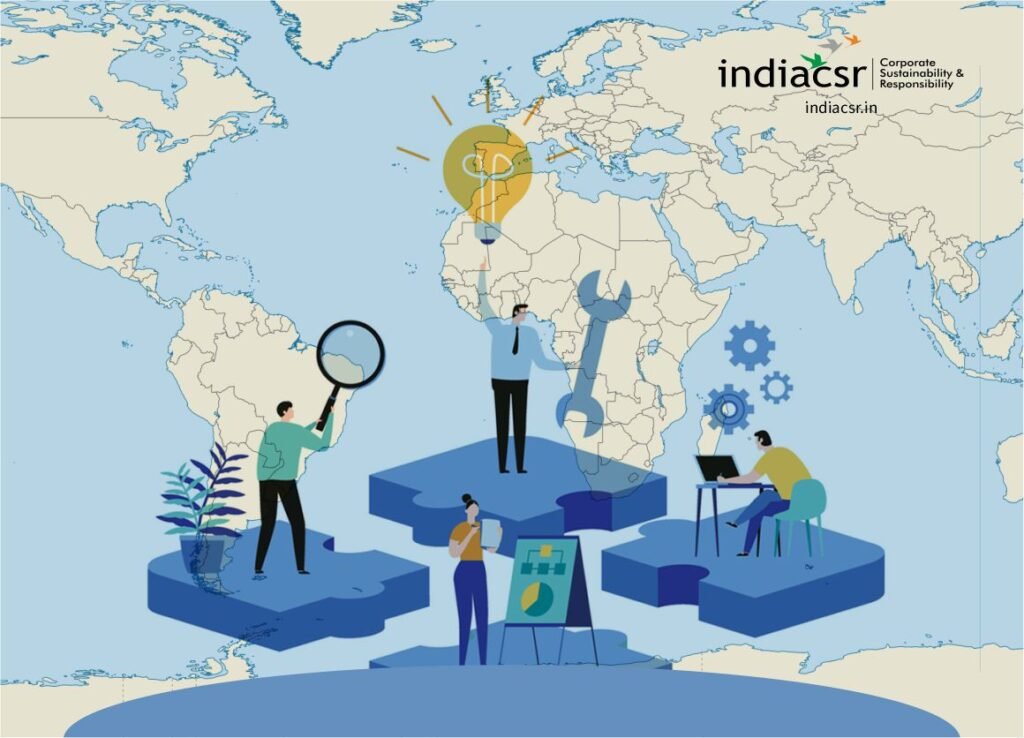5 Ways India is Empowering its Tech and Startup Scene with Skilling Initiatives, International Partnerships, Cloud Computing, Data Facility Upgrades, and $8.6B in Leveraged Funds
With a population of over 1.3 billion people, India has immense potential to become a worldwide technology powerhouse. To accomplish this, the country must address its skill gap by implementing nationwide skilling projects. Skill India Initiative and Skill India Mission Operation, as well as public-private partnerships, are trying to provide job-ready skills training to India’s tremendous talent pool of youth. Furthermore, growing access to foreign education, online skill training, and collaborations with tech behemoths such as Google, Amazon, and Microsoft are making in-demand talents and worldwide exposure more accessible.
Welcome to a discussion on India’s tech and startup empowerment in the digital age.

1. Bridging Skill Gap through Skilling Initiatives
- Skill India Initiative and Skill India Mission Operation
The government skill gap predicts a need for over 109 million skilled workers to fill vacant positions in 2022. This move is making it crucial to promote skilling initiatives nationwide. The Skill India Initiative was launched in 2015. It aimed at providing job-ready skills training to 400 million individuals by 2022. However, among students leaving school, only 2.3% have had the opportunity to acquire job-specific skills. To address this opportunity, the World Bank has approved a $250 million project called the Skill India Mission Operation (SIMO) aimed at providing training for market-relevant skills to make youth talent employable and competitive by world standards.
- Training and Curriculum Design
The Skill India Mission Operation (SIMO) targets emerging labor market trends to enhance the training quality of their ambitious programs. Furthermore, public-private partnerships are intended to design the latest curriculum for skilling in the country. A Corporate Social Responsibility (CSR) fund has been set up to gather contributions from the private sector’s CSR activities for the purpose of skill development. Numerous national and international universities have come together in the past five years to make quality education more accessible to aspirants.
- Access to International Education
Increased access to international education has led to more Indian students venturing abroad in search of new knowledge and opportunities. However, educational partnerships with overseas institutions and associates have risen to offer flexible certification programs and foundation courses online for the vast youth talent pool that cannot afford overseas education. Governments, educational institutions, and private sector establishments need to focus on building infrastructural capacity to improve the employability index of India’s population.
- Online Skill Training for Indian Youth
With over 624 million Internet users, it is estimated that 45% of India’s population has access to the Internet. It is important to note that Indians on average spend 2.5 hours using social media platforms. Using targeted ads and outreach activities, e-learning companies, universities, and training institutes are reaching out to a vast majority of the youth online, in an attempt to promote future-handy skills.
- Tech Giants and Indian Universities Join Forces for Job-Ready Workforce
By introducing partnerships with tech giants such as Google, Amazon, and Microsoft, reputed Indian universities have tailored various certifications to enable a job-ready workforce for the future. Platforms such as Coursera, UpGrad, GreatLearning, Unacademy, and GrowthSchool among numerous other e-learning pioneers have risen up to make in-demand skills and international exposure accessible to professionals and students. With a key emphasis on future jobs in Data Science, Machine Learning, Design Thinking, etc. premier educational institutions and corporations are merging with the e-learning market.

2. Empowering Indian Industry through IT and Startups
- Cloud Computing Driving Innovation in Indian Industry
The Indian industry is evolving with the latest technologies. 92% of all organizational IT infrastructure relies on cloud computing, while only 8% state that their IT is on-premises. According to Cisco, 94% of all enterprise workloads by the end of 2021 will be powered by the cloud. To catch up to global advancement, the National e-Governance Plan and GI Cloud Initiative by the Government of India is setting up National Data Centers, and State-Wide Area Network Infrastructure in varying parts of the nation. This will speed up innovation at scale in the Indian IT labs and engineering facilities.
- Revamping India’s Data Facilities
The plan set in place to transform India’s data facilities will span over a period of 4 years, from 2021 to 2025. The renewed capacity is estimated to reduce dependencies on overseas markets for technology infrastructure and managed services, thus empowering home-grown IT development. Additionally, government initiatives to support startups in India have witnessed favorable results in the Indian tech and entrepreneurial landscape.
- India’s Potential in the Global Tech Industry
To emerge as a key player in technology, India will have to capitalize on the available talent and chart a clear path toward innovation and development. The skilling initiatives, partnerships with tech giants, and infrastructure development plans are steps in the right direction. However, it is crucial for the government, educational institutions, and private sector establishments to collaborate and take accountability for emerging market demands. With the right focus and investment, India has the potential to become a leading force in the global technology industry.

3. Challenges and Opportunities of Mobile-Friendly Skilling
- Mobile-Friendly Skilling in India: Challenges and Opportunities
Considering that 76% of India’s internet usage happens on mobile, the mobile-friendly approach offered by online skilling programs is a bonus. However, for practical skill-based training, access to computers may prove vital where only 22% of internet usage happens on a laptop or desktop.
India being the chief marketplace of conglomerates such as Google, Amazon, Facebook, and Microsoft, resulted that the IT investments in local startups also going up during the past year. With a renewed interest in the employability of the Indian workforce, international partnerships are expected to further re-engineer the skilling ecosystem in the coming years. According to the Reserve Bank of India, Foreign Direct Investment increased by $2.235 billion in July 2021.
- Foreign Investment Boosting India’s Tech and Startup Scene
Compared to the investment of $17.689 billion recorded in the peak of October 2020, this is still great news. The results of foreign interest have sprung up in the form of new tech startups, improved technologies, international partnerships, wellness brands, and better prices on foreign goods available in India. Access to high-quality resources has led to significant improvements in e-commerce, retail, e-learning, software development, insurance, and national governance policies.
In fact, the period between 2019-2021 has witnessed the rise of several native social media apps, software products, e-commerce websites, energy partnerships, and social enterprises. These trends are set to impact the employability landscape of India through technology familiarity that is centered around the future demands of a modern workplace equipped with digital tools. Inevitably, the advent of a modern workplace comes with in-demand skills for employees who are not just analytical thinkers but strategic partners in identifying growth opportunities at their work.

4. Infrastructure Upgrades and Startup Empowerment
- India’s Cloud Computing Evolution and Data Facility Transformation
The Indian industry is evolving with the latest technologies. 92% of all organizational IT infrastructure relies on cloud computing, while only 8% state that their IT is on-premises. According to Cisco, 94% of all enterprise workloads by the end of 2021 will be powered by the cloud. To catch up to the global advancement, the National e-Governance Plan and GI Cloud Initiative by the Government of India is setting up National Data Centers and State-Wide Area Network Infrastructure in varying parts of the nation. This will speed up innovation at scale in the Indian IT labs and engineering facilities.
- Infrastructure Upgrades and Startup Empowerment
The plan set in place to transform India’s data facilities will span over a period of 4 years, from 2021 to 2025. The renewed capacity is estimated to reduce dependencies on overseas markets for technology infrastructure and managed services, thus empowering home-grown IT development. Additionally, government initiatives to support startups in India have witnessed favorable results in the Indian tech and entrepreneurial landscape.
- Indian Startups: $8.6B Funds Leveraged & Consistent Software Development
With an 80% rise in startup investments from 2020, a total of $8.6 billion in funds has been leveraged by Indian startups. The massive influx of youth talent to the market benefits from this development in the startup ecosystem, as the likes of Zomato, Byju’s, Zoho, Ola, Flipkart, Razorpay, EaseMyTrip, Paytm, Classplus, and numerous others are likely to hire more candidates in the coming years. The field of software development has witnessed a consistent flow of products hitting the market, with innovative uses and concepts that will lead the way forward for Indian IT.

5. Promoting Innovation and Development in Indian IT
- Harnessing the Digital Revolution to Reduce India’s Skill Gap
India’s rapid development in IT and technology adoption has made it a key player in the global digital revolution. However, the skill gap in India is still a major concern that needs to be addressed. The first phase of Pradhan Mantri Kaushal Vikas Yojana (PMKVY) managed to train 1.97 million people, and 1.27 million certifications were successfully provided. Still, there are close to 15 million people aged 15-29 expected to enter India’s working population annually for the next decade. Major infrastructural changes and skilling measures are still required to bridge the skill gap in India by 2022.
- 5.2 Improving Youth Employability
India Skill Report 2022 has identified a steady climb in overall youth employability and recognizes the immense effort of India’s skilling ecosystem, many of them being partners in this year’s study. With a renewed focus on building infrastructural capacity and addressing emerging market demands, governments, educational institutions, and private sector establishments can improve youth employability in India. The good news is, India’s growth in the tech and entrepreneurial landscape is promising, and the path forward for digitalization is a hopeful endeavor.
- 5.3 India’s Skilling Ecosystem and the Mobile-Friendly Approach
Considering that 76% of India’s internet usage happens on mobile, the mobile-friendly approach offered by online skilling programs is a bonus. However, for practical skill-based training, access to computers may prove vital where only 22% of the internet usage happens on a laptop or desktop.
India being the chief marketplace of conglomerates such as Google, Amazon, Facebook, and Microsoft, resulted that the IT investments in local startups also going up during the past year. With a renewed interest in the employability of the Indian workforce, international partnerships are expected to further re-engineer the skilling ecosystem in the coming years. According to the Reserve Bank of India, Foreign Direct Investment increased by $2.235 billion in July 2021.
About the Author
One of the top leaders championing youth capacity growth throughout India is Ketan Deshpande. He is the founder, chairman, and CEO of FUEL or Friends Union For Energizing Lives, as well as a visiting fellow at Cambridge, UK’s JBS University.
Also Read: Realizing India’s Potential via Skills as a Potent Discipline – India CSR
Also Read: Four Pillars for Making India a Skill Country By Ketan Deshpande I India CSR
Views are personal.
Copy Right @ India CSR






